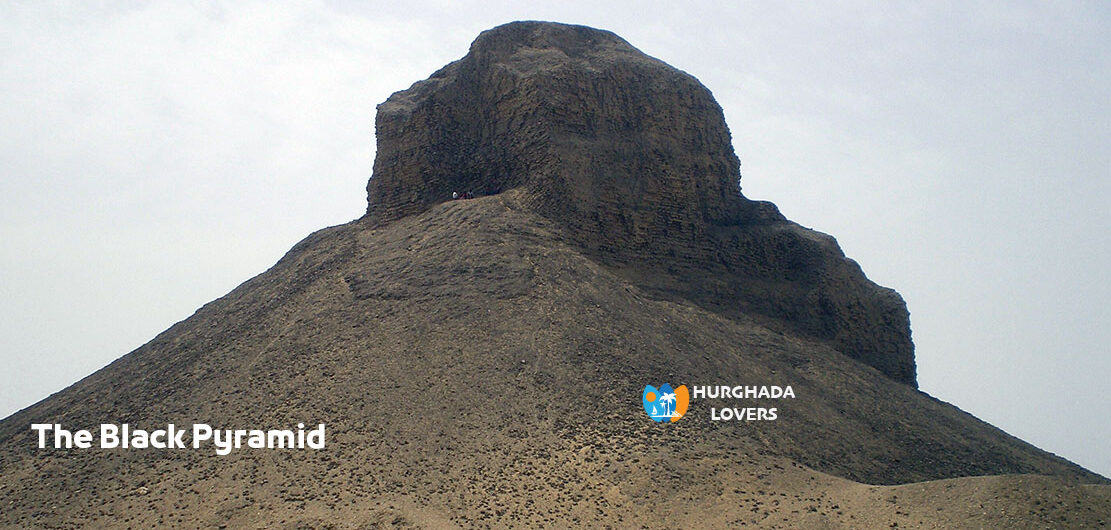The Black Pyramid in Dahshur, Saqqara, Egypt – Egyptian Tombs
Facts about Egyptian tombs and the history of building the pyramid of King Amenemhat III in ancient Egyptian civilization, why was it called by this name and what are the working hours and entry ticket prices and more to discover the Ancient Egypt History and what are The Secrets of Pyramid Construction.
The Black Pyramid Facts
King Amenemhat III, the most famous of the pharaohs of the Twelfth Dynasty of Egypt, is attributed to the Middle Kingdom of Egypt with two pyramids, one in Dahshur and the other the Hawara Pyramid in Fayoum.
The first is called the “Black Pyramid” and is made of mud brick. It does not appear that the king used it..
Let us not forget that the pharaohs built their pyramids near their palaces of rule, such as the Black Pyramid. We accept the opinion that Amenemhat III ruled first in Itjtawy like his predecessors, so why did he build a pyramid in Dahshur in the exiled region of mud bricks, where we found his pyramid made of polished black granite, the most famous Ancient Egyptian Metallurgy, beautifully, and on it is an inscription in Ancient Egyptian Language hieroglyphics talking about the protection of God Ra-Horakhty for the king, the most famous Egyptian deities – Ancient Egyptian gods and Goddesses in the Ancient Egyptian religion, and a friendly reception in the Western Mountain.
At a date that we cannot pinpoint accurately, Amenemhat III adopted a new habit, which was to reside in Fayoum to closely monitor the major works being carried out in Lake Moeris and the decoration of the Temple of God Sobek, the most famous Egyptian Temples, and the construction of the Labrante Palace.
At that time, he built a new pyramid in one of the corners of the Labrante. Although the architects were very careful to hide the pharaonic Ancient Egyptian Coffins from the hands of the Ancient Egyptian Grave Robbers, they reached it, lifted the cover, and took it, leaving only the coffin made of quartzite, indicating the development of Industry in ancient Egypt and the art of Sculpture in Ancient Egypt.
King’s burial place:
We cannot prove materially that the king was buried in Hawara or in the Black Pyramid, but it is always possible.
Within the wall of the Dahshur pyramid, several tombs were built, including the tomb of King Hor Awibre, whom the Turin List makes the most famous Ancient Egyptian Papyrus of the Thirteenth Dynasty.
Egyptology were divided over this king, with some agreeing with the Turin List while others went so far as to say that he and Amenemhat III had built a canopic jar lid bearing the name of King Hor and sealed with the name of Maat-Re. However, in ancient times, the name of the deceased king was used in the seal after his death..
This did not rise as evidence, and I do not believe that Amenemhat III shared with another king in ruling in ancient Egypt “Ancient Egyptian Government“.
Upon his death, the throne of God Horus went to King Amenemhat IV, who ruled for eight years and continued to invest in the turquoise mines in Sinai and obtained the Coronation of the Pharaohs.
He followed the example of his predecessor and sent gifts to King Ipshemwapi, the son and successor of Abishemu..
But the days of Itet-tawy were numbered, after the short reign of Queen Sobekneferu, the most famous of the pharaonic queens of Egypt “Female Pharaohs“, power passed into other hands.
Who knows if Amenemhat III did not realize that his family and all of Egypt would witness bad days? The sculptors of Karnak expressed in their own way the feelings and emotions of this king.
Statues of King Amenemhat III:
There are other statues carved that are not different from the unique Hawara statue next to the Black Pyramid, all of which date back to his early years in power, but there are others that depict him as he grew older. In the Leningrad statue and the Moscow statue, the features and facial shape are similar, but the feelings of happiness have faded..
Three statues were found in The Royal Cache of Deir el-Bahri and the Karnak Temple and are displayed in The Egyptian Museum (Museums in Cairo) in Tahrir Square with numbers that confirm this impression; the king is concerned with serious problems.
As for statue No. 1, which came from the same place, it represents the image of a tired man withdrawn into himself and his body wasted..
His face was filled with worries and sorrows, and his eyelids, which were already suffering from old age, became heavy. How do we explain this contradiction? We do not believe that the army in ancient Egypt suffered setbacks.
We do not believe that there was a conspiracy against the king’s life, as the documents do not indicate these matters. Amenemhat IV co-ruled with Amenemhat III in the year 44, but this co-rule was a custom followed in the Twelfth Dynasty; it was a known act in advance and did not worry him..
Note: Facts and secrets of the history will be added soon…
Hurghada Excursions Lovers, Best Travel Agency in Hurghada to provide daily tours to visit the Tourist attractions of Luxor by Hurghada to Luxor Tours and Hurghada to Pyramids Trips. Book online when you come to Hurghada, El Gouna, Sahl Hashish, Makadi Bay, Soma Bay.

